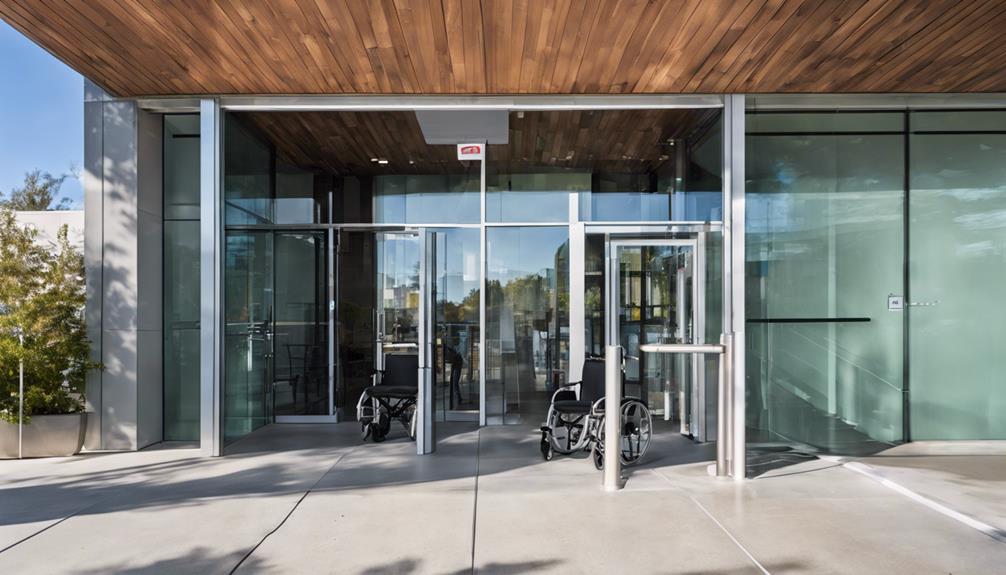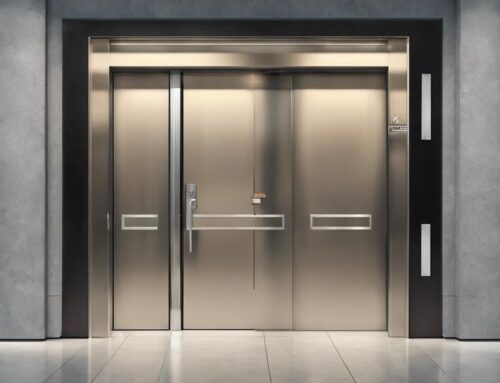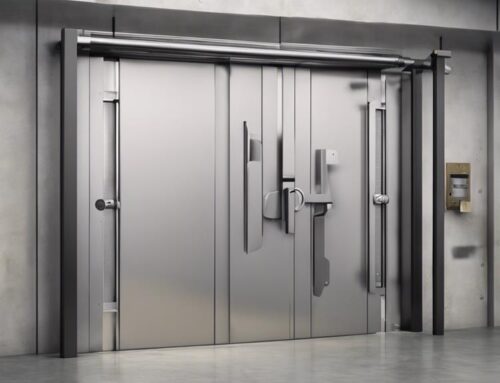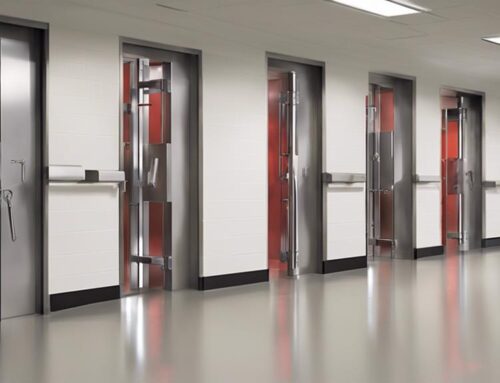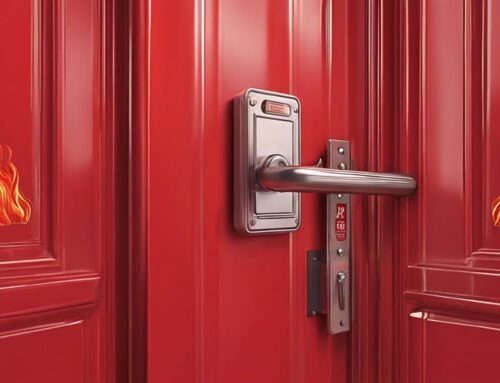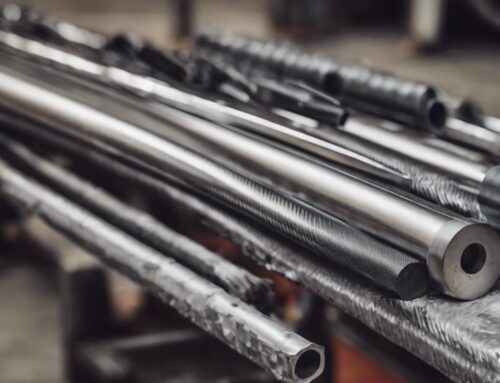To guarantee your panic bars comply with ADA standards, install them between 34 and 48 inches from the floor. They should be operable with one hand without needing tight grasping or twisting. The activation force must not exceed 15 pounds, ideally around 5 pounds for users with reduced strength. Confirm the doorway is at least 32 inches wide and maintain clear floor space—18 inches wide by 54 inches deep in front of the bar. Proper signage like "Push to Open" is also essential. By following these guidelines, you'll enhance safety and accessibility in your building. There's much more to verify full compliance.
Key Takeaways
- Panic bars must be installed between 34 and 48 inches from the floor to comply with ADA height requirements.
- ADA-compliant panic bars should be operable with one hand and require no more than 5 pounds of force.
- Clear floor space of at least 18 inches wide by 54 inches deep is necessary in front of panic bars.
- Smooth surfaces and clear "Push to Open" signage are essential for easy identification and safe use of panic bars.
- Regular inspections are crucial to ensure panic bars remain functional and compliant with ADA standards.
Understanding ADA Requirements
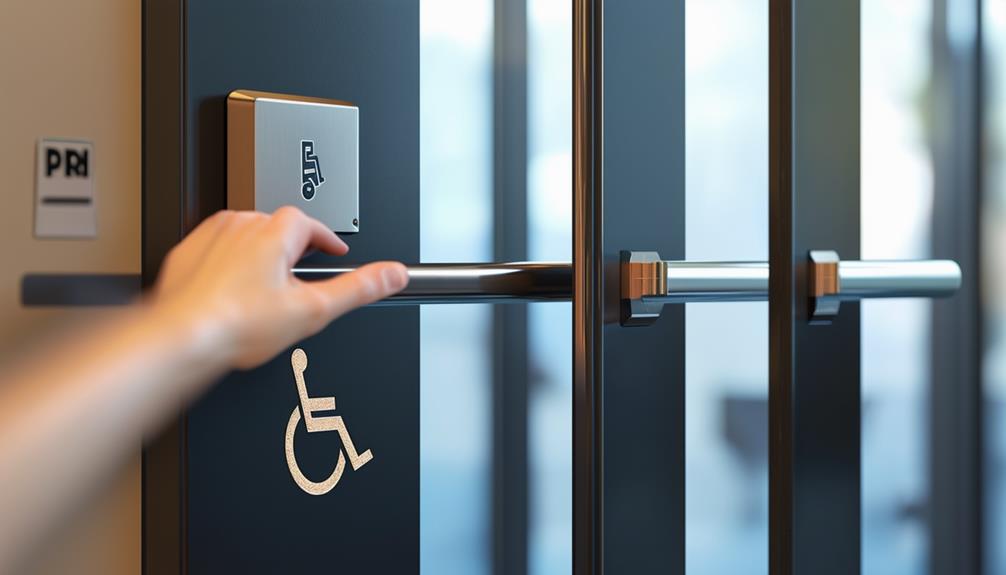
Understanding ADA requirements for panic bars is fundamental for guaranteeing that buildings are accessible and safe for everyone, including individuals with disabilities. To achieve ADA compliance for panic bars, you need to verify they are installed at a height between 34 and 48 inches from the floor. This height range is imperative for accessibility, especially for individuals using wheelchairs. Panic bars must be operable with one hand and designed to prevent tight grasping, pinching, or twisting of the wrist. This feature is essential for accommodating users with limited dexterity. Another significant aspect of ADA panic bar requirements is the activation force, which should not exceed 15 pounds. However, a maximum of 5 pounds is recommended to support individuals with reduced upper body strength. Panic bars can further enhance safety by integrating with fire alarms, providing timely alerts during emergencies.
It's important to verify panic bars provide a minimum width of 32 inches for door openings, facilitating safe and efficient egress during emergencies. Additionally, maintaining clear floor space in front of panic bars is necessary for maneuverability. This guarantees individuals can easily access the exit in emergency situations. Adhering to these ADA panic bar requirements will help create a safer and more accessible environment for all building occupants.
ADACompliant Panic Bar Models
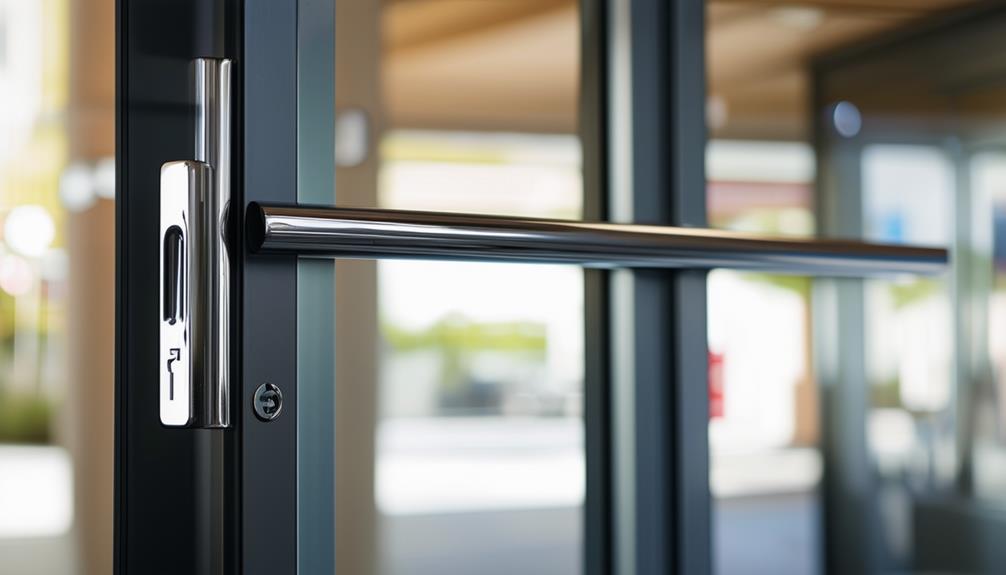
When selecting ADA-compliant panic bar models, you'll often find that they are meticulously engineered to meet both accessibility and safety standards. These models must be mounted at a height between 34 and 48 inches from the floor, guaranteeing they are reachable for individuals with disabilities. ADA-compliant panic bars are designed for one-handed operation and require no more than 5 pounds of force to activate, accommodating users with limited upper body strength. It is also vital that the installation and consultation services adhere to fire code safety laws.
Additionally, the width of these panic bars must allow for a minimum clear opening of 32 inches. This guarantees that wheelchair users can easily access the exit. The surfaces of the panic bars are smooth and free of sharp edges, minimizing the risk of injury. Clear signage indicating "Push to Open" is vital for easy identification and use.
Regular inspections and maintenance of ADA-compliant panic bars are essential to guarantee they function correctly and comply with ADA panic bar regulations. By focusing on these features, you can guarantee that your panic bar models not only meet regulatory standards but also provide safe and accessible egress for all users. Prioritize these elements to maintain a compliant and secure environment.
Installation for ADA Compliance
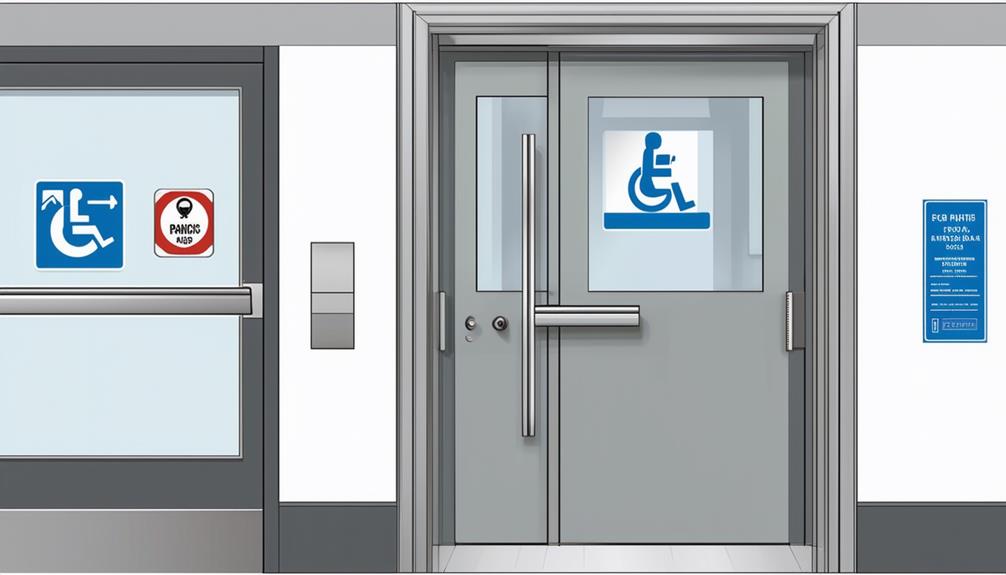
Guaranteeing proper installation for ADA compliance is fundamental to making spaces accessible and safe for all users. When you're handling an ADA panic bar installation, it's essential to position the bar at a height between 34 and 48 inches from the floor. This range assures that individuals using wheelchairs can easily access and operate the panic bar. Experienced technicians with specialized training in panic bar installation guarantee secure installation practices for device reliability, aligning with ADA standards.
Mount the panic bar on the door's surface, ensuring it can be operated with one hand without requiring tight grasping, pinching, or twisting of the wrist. This feature is critical for ADA panic bar accessibility, accommodating users with various physical limitations.
Also, make certain there's clear floor space in front of the panic bar to facilitate maneuverability. This means keeping the area free of obstacles, guaranteeing ease of access in emergencies.
Regularly assess the installation height and functionality of the panic bars. They should activate with no more than 15 pounds of force, though aiming for a maximum of 5 pounds is recommended for those with limited upper body strength. Compliance testing is key to confirming these standards, guaranteeing the bars operate smoothly and meet all ADA requirements.
Common ADA Violations
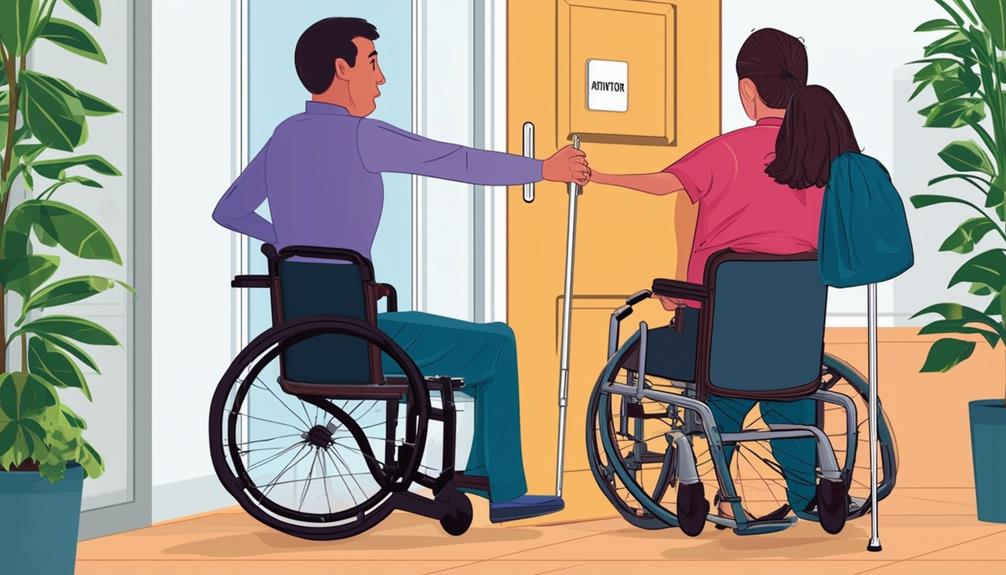
Steering through ADA compliance can be tricky, especially with the common violations that arise with panic bars. You need to understand the specifics of ada panic bar guidelines to avoid falling foul of panic bars and ada laws. One frequent issue is the installation height. Panic bars must be installed between 34 and 48 inches from the floor. If they fall outside this range, they impede accessibility for individuals with disabilities. Another common violation is the force required to activate the panic bar. ADA standards limit activation force to a maximum of 5 pounds. If your panic bar requires more force, it won't accommodate users with limited strength. Many types of panic bars are designed to meet these regulations, but correct installation is essential.
Common ADA Violations:
- Incorrect Installation Height: Must be 34-48 inches from the floor.
- High Activation Force: Must not exceed 5 pounds of force.
- Obstructions: Clear floor space must be maintained around panic bars.
Obstacles such as furniture or signage in front of panic bars can obstruct the necessary maneuverability space. Panic bars should also be operable with one hand without tight grasping, pinching, or twisting the wrist. Finally, make sure clear signage is provided to indicate the location and function of panic bars, as visibility is vital during emergencies.
Audit Checklist for Compliance
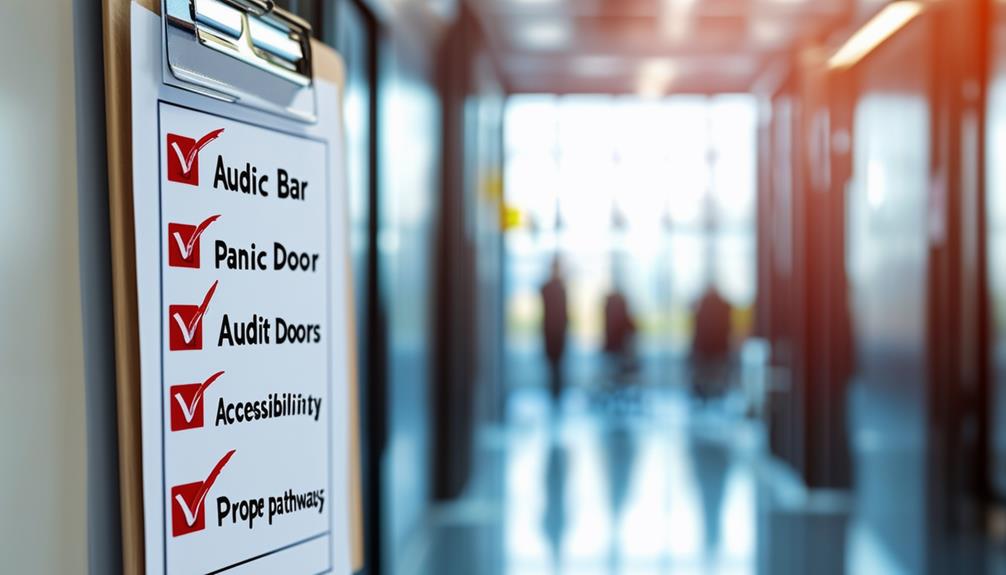
Creating an effective audit checklist for ADA compliance is essential to guarantee that your panic bars meet all necessary standards. First, verify that your panic bars are mounted at a height between 34 and 48 inches from the floor. This height range is critical for accessibility and aligns with ADA panic bar standards. For businesses looking to comply, professional services like Low Rate Locksmith offer affordable installation solutions that meet these criteria.
Next, verify that the panic bars can be operated with one hand. There should be no need for tight grasping, pinching, or twisting of the wrist. This guarantees that individuals with limited hand mobility can easily use the panic bars, meeting ADA operational standards.
Then, confirm that the activation force required to operate the panic bars does not exceed 5 pounds. This low force requirement is essential for ease of use and is a key component of the panic bar ADA compliance checklist.
Additionally, check for a clear floor space of at least 30 inches by 48 inches in front of the panic bars. This space provides adequate maneuverability, especially for individuals using wheelchairs.
Retrofit Options for Compliance
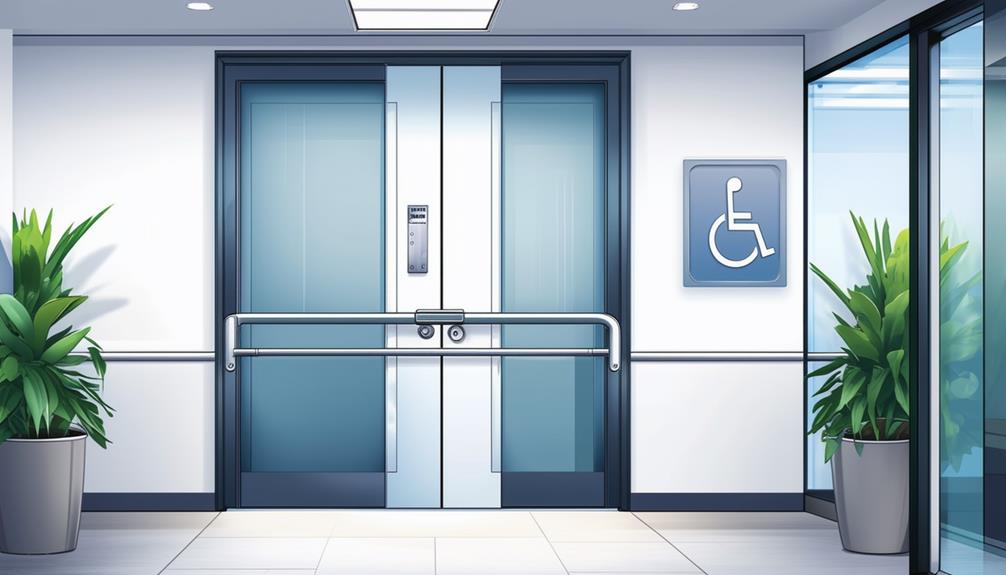
Upgrading your existing panic bars to meet ADA compliance can be straightforward with several retrofit options available. By addressing key aspects such as height, operability, and accessibility, you can verify your panic bars meet the necessary standards. Leading brands like Von Duprin offer extensive solutions tailored to these requirements. Here are three effective options to evaluate:
- Replace Existing Hardware: Installing compliant panic bars that meet ADA height (34-48 inches) and operability requirements is essential. These models can be activated with one hand, and without tight grasping or twisting, guaranteeing ease of use for all individuals.
- Add Extension Arms or Adapters: If replacing the entire unit isn't feasible, extension arms or adapters can elevate existing panic bars to the required height. This option can save costs while still achieving compliance.
- Install Push Pads or Alternative Devices: Push pads are a great retrofit solution that facilitates easier access for people with disabilities. These devices align with ADA standards for operable parts, enhancing functionality and accessibility.
Best Practices
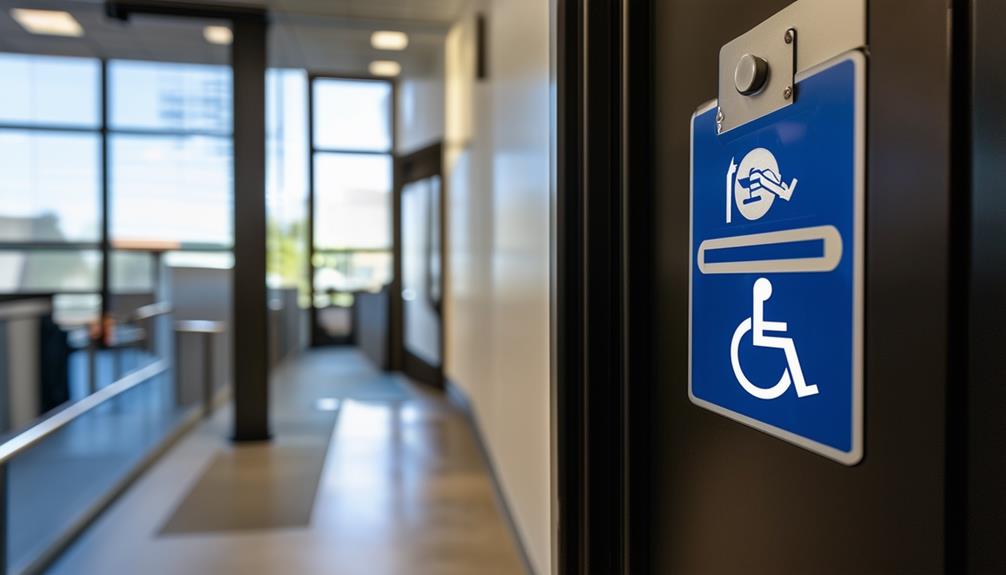
Implementing best practices for ADA compliance in panic bars guarantees safety and accessibility for all users. First, verify your panic bars are mounted between 34 and 48 inches above the floor. This height range makes them accessible to individuals using wheelchairs, aligning with ADA standards. For professional guidance, consider seeking expert panic bar solutions to confirm compliance and reliability.
Next, focus on the activation force. ADA panic bar solutions should require no more than 5 pounds of force to operate. For emergency egress, aim for a maximum of 15 pounds. This verifies that users of all abilities can easily operate the bars in emergency situations.
Clear floor space is essential. Provide at least 18 inches wide by 54 inches deep of unobstructed space in front of each panic bar. This allows for maneuverability and safe access, essential for wheelchair users and others with mobility challenges.
Design is also key. Panic bars should be operable with one hand and shouldn't require tight grasping, pinching, or twisting of the wrist. This verifies they accommodate users with varying physical abilities.
Lastly, conduct regular inspections and maintenance checks. This keeps your panic bars functional, compliant, and free from obstructions, thereby confirming ADA compliance for panic bars at all times.
Legal Implications of NonCompliance
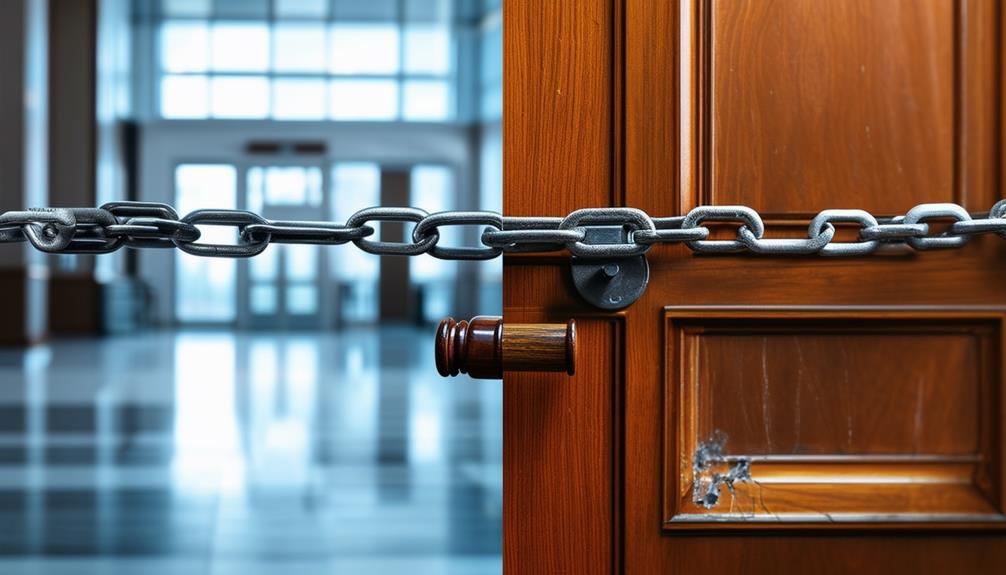
Failing to comply with ADA standards for panic bars can lead to severe legal consequences that organizations can't afford to ignore. If your facility is found non-compliant, you could face considerable fines and lawsuits, which may be pursued by individuals who encounter accessibility issues. Legal ramifications range from hefty penalties to costly settlements, and these can escalate based on the severity and frequency of the violations. Additionally, non-compliance can compromise the overall security of your business, making it essential to secure your facility with expert exit device services. Low Rate Locksmith offers cost-effective repair and replacement services for exit devices to guarantee your compliance and security.
Here are three critical points to reflect on:
- Financial Penalties: Non-compliance can result in fines amounting to thousands of dollars, greatly impacting your budget.
- Legal Actions: Individuals or advocacy groups may initiate lawsuits, leading to expensive settlements and ongoing legal costs.
- Reputational Damage: Negative publicity from non-compliance can erode customer trust and damage your brand's reputation.
Conducting regular audits is essential to guarantee adherence to ADA regulations. If neglect is documented, it can serve as damning evidence in court. Remember, the ada panic bar cost and ada panic bar certification are investments in your legal protection and public image. By prioritizing compliance, you avoid potential legal pitfalls and maintain a positive standing in the community.
Case Studies

Ensuring ADA compliance for panic bars is vital, and real-world case studies highlight its tangible benefits. In a public school, installing ADA-compliant panic bars on all exit doors led to a 30% improvement in evacuation times during fire drills. This clearly demonstrates how ADA panic bars can enhance safety and efficiency in emergency situations. Additionally, customizable panic bar solutions from Low Rate Locksmith can be tailored to meet specific safety and aesthetic requirements, adding an extra layer of assurance.
In a healthcare facility, the implementation of panic bars meeting ADA standards was essential. This upgrade greatly reduced incidents where individuals with disabilities couldn't exit during emergencies, resulting in zero reported injuries over three years. This underscores the critical importance of ADA panic bar upgrades in environments where vulnerable populations are present.
A retail store experienced a 20% increase in foot traffic after upgrading to ADA-compliant panic bars. Customers appreciated the enhanced accessibility, highlighting the positive impact of these upgrades on business attractiveness and inclusivity.
An office building's compliance audit revealed that retrofitting existing panic bars to ADA specifications decreased the likelihood of potential legal actions and fines by 50%. This shows the financial and legal advantages of ensuring compliance.
Training for Installers
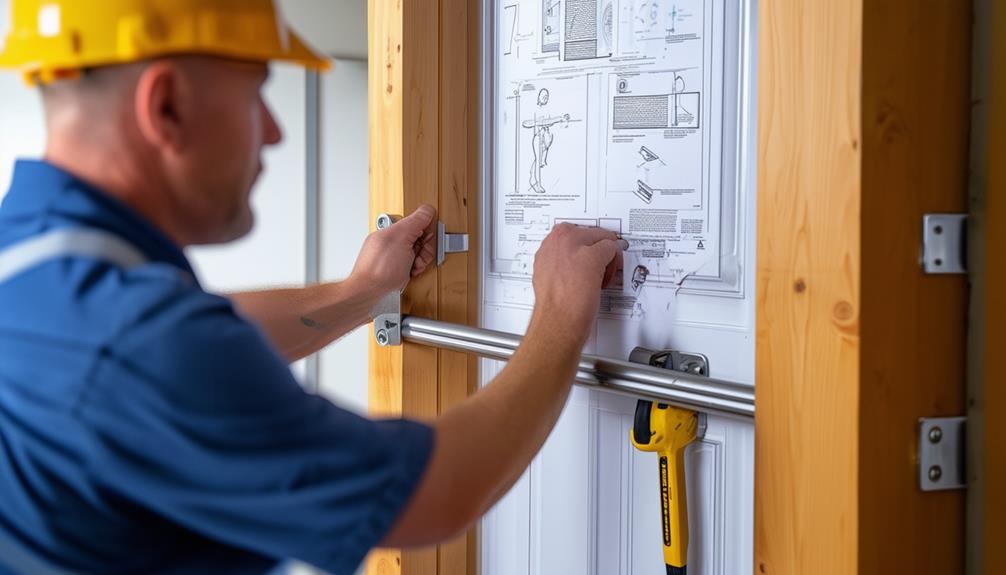
When focusing on training for installers, it's important to guarantee they're versed in ADA height requirements for panic bars, which must be mounted between 34 and 48 inches from the floor. This assures accessibility for all users. Beyond height, installers need to understand that ada approved panic bars should require no more than 5 pounds of force to activate, accommodating individuals with limited strength. For an added layer of safety, confirm that regular compliance inspections are conducted to maintain safety standards.
Proper alignment and installation techniques are significant. Installers should make certain smooth operation without requiring tight grasping, pinching, or twisting of the wrist. Familiarity with local building codes and regulations is also necessary, as compliance must be maintained throughout the building's lifespan.
Key Training Areas:
- Height and Force Requirements: Confirming panic bars are installed at the correct height and require minimal force to operate.
- Alignment Techniques: Mastering installation methods to avoid issues like tight grasping or pinching.
- Code Compliance: Staying up-to-date with local codes and regulations to guarantee ongoing ADA compliance.
Ongoing training on maintenance practices is critical. Regular inspections and repairs keep ada compliant panic bars functional and up to standard, securing the safety and accessibility of the building for years to come.
Ensuring ADA Compliance: Low Rate Locksmith's Expert Panic Bar Solutions
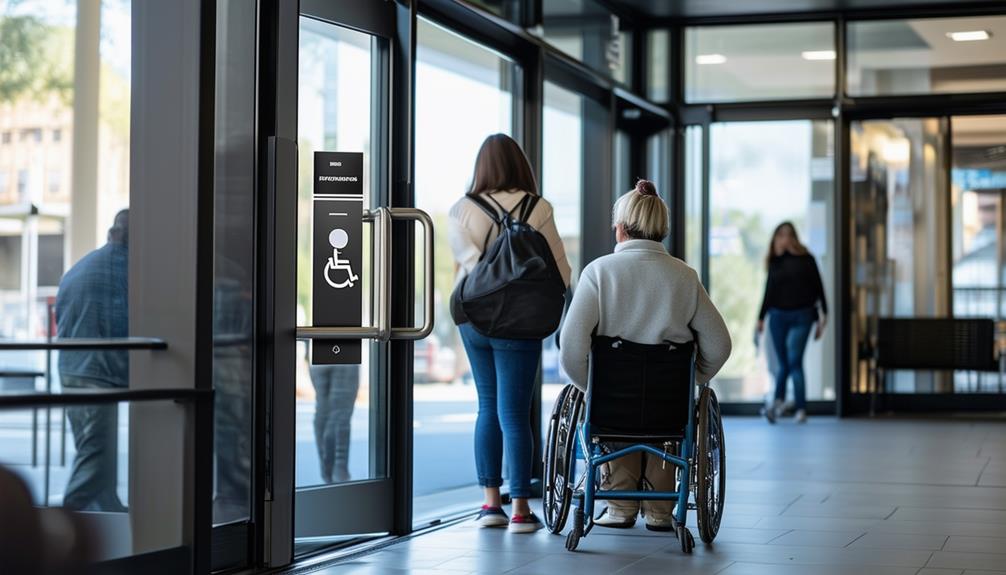
In addition to rigorous training for installers, partnering with a trusted provider like Low Rate Locksmith guarantees your panic bars are always up to code. Their ADA panic bar products meet all necessary specifications, allowing operation with one hand and requiring a maximum activation force of 5 pounds. This makes them suitable for individuals with disabilities, assuring accessibility and safety during emergencies.
Low Rate Locksmith's panic bars are installed at a height of 34 to 48 inches above the floor, aligning with ADA height requirements. This precise installation assures that the bars are within reach for all users. Moreover, their panic bars are designed with a smooth surface and no sharp edges, enhancing safety during use.
To maintain compliance, Low Rate Locksmith offers regular ADA panic bar maintenance services. These include inspections to verify functionality and adherence to the latest ADA regulations. Clear signage indicating "Push to Open" is also provided, promoting easy identification and use, especially in high-stress situations.
Frequently Asked Questions
What Are the ADA Requirements for Panic Bars?
You need to guarantee panic bars are mounted 34-48 inches above the floor. The activation force shouldn't exceed 15 pounds, ideally 5 pounds. Operate them with one hand, without tight grasping, pinching, or wrist twisting. Provide clear floor space in front for maneuverability. Panic bars must be easily identifiable with "Push to Open" signage. This guarantees accessibility and safety for individuals with disabilities.
What Are the Code Requirements for Panic Bars?
Code requirements for panic bars include specific mounting heights, usually between 34 and 48 inches from the floor, and an activation force not exceeding 5 pounds. They should be operable without tight grasping, pinching, or twisting of the wrist, and must be usable with one hand. Confirm there's clear floor space in front for accessibility, and verify compliance with local building codes and emergency function standards through testing.
What Are the Standards for Panic Hardware?
For panic hardware standards, you need to guarantee it's operable with one hand, without tight grasping, pinching, or twisting the wrist. Mount it between 34 and 48 inches above the floor. The activation force should be no more than 15 pounds, ideally 5 pounds for those with limited strength. Guarantee a minimum door width of 32 inches and maintain clear floor space in front for unobstructed egress during emergencies.
Are Push Bars ADA Compliant?
Imagine a door as a gateway to freedom, symbolizing accessibility for everyone. Yes, push bars are ADA compliant when they meet specific criteria. They must be operable with one hand, without tight grasping, pinching, or twisting. Installed between 34-48 inches from the floor, they should require no more than 5 pounds of force. Clearly marked and inspected regularly, these bars guarantee smooth operation and adherence to ADA standards, promoting inclusivity.
Conclusion
Wrapping it all up, ensuring ADA compliance for panic bars is essential for accessibility and legality. You've learned the ins and outs, from selecting ADA-compliant models to proper installation. Remember, cutting corners can lead to serious legal consequences. Following the audit checklist and training your installers will keep you above board. At the end of the day, Low Rate Locksmith's expert solutions can help you hit the nail on the head, ensuring your panic bars are fully compliant.

